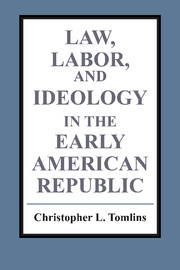Book contents
- Frontmatter
- Contents
- Preface and acknowledgments
- Prologue: two moments of the republic
- PART 1 LAW AND THE FACTS OF AMERICAN LIFE
- PART 2 LAW, LABOR, AND STATE
- PART 3 LAW, AUTHORITY, AND THE EMPLOYMENT RELATIONSHIP
- An interlude: on law and economy
- PART 4 THE NEW INDUSTRIAL ORDER
- Epilogue: “free Ameriky”
- Index
Prologue: two moments of the republic
Published online by Cambridge University Press: 05 August 2012
- Frontmatter
- Contents
- Preface and acknowledgments
- Prologue: two moments of the republic
- PART 1 LAW AND THE FACTS OF AMERICAN LIFE
- PART 2 LAW, LABOR, AND STATE
- PART 3 LAW, AUTHORITY, AND THE EMPLOYMENT RELATIONSHIP
- An interlude: on law and economy
- PART 4 THE NEW INDUSTRIAL ORDER
- Epilogue: “free Ameriky”
- Index
Summary
THE FIRST MOMENT
1798 was the year of XYZ, of the Alien and Sedition acts, of the “Federalist Reign of Terror,” of the Kentucky and Virginia Resolves – a year of dramatic events that congealed into one of the most severe of the many moments of crisis that haunted the early history of the American republic. 1798 was also the year William Manning of Billerica, Massachusetts, laboring in obscurity, completed a remarkable work of politics, which he called The Key of Libberty. Dubbed somewhat condescendingly the work of a “village Hampden” by the youthful Samuel Eliot Morison (“we do not claim to have discovered a forgotten Locke or a homespun Montesquieu,” wrote Morison a shade regretfully, contemplating Manning's untutored scrawl), The Key of Libberty instances its author's growing concern that what little was left of the revolutionary achievement two decades past was about to disappear beneath a rising tide of Federalist reaction. What Manning wrote, however, is misunderstood if thought of simply as the gloomy response of a staunch Jeffersonian to the contemporary travails of his party: The Key of Libberty was no humdrum partisan tract but a detailed critical constitutional commentary designed both to address “the causes why a free government has always failed” and to suggest “a remidy against it.”
- Type
- Chapter
- Information
- Publisher: Cambridge University PressPrint publication year: 1993



